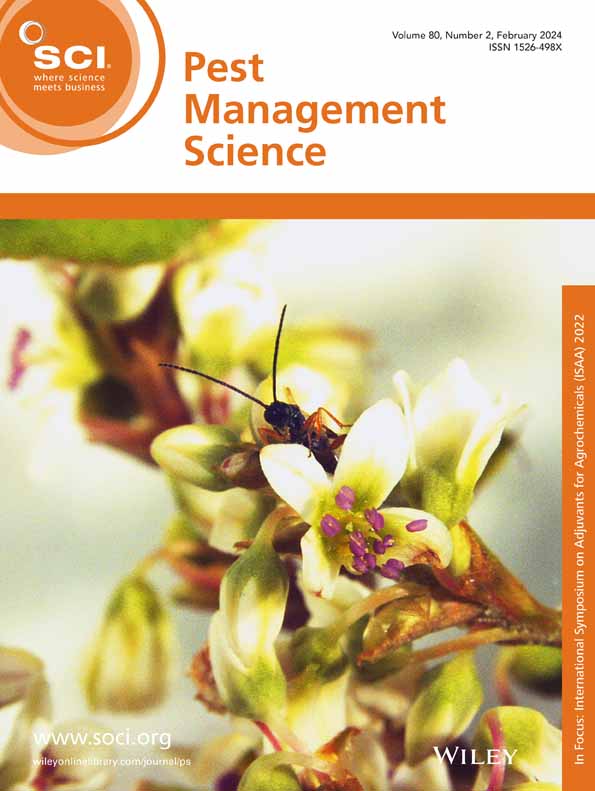Mechanism and control efficacy of plasma-activated water seed treatment against bacterial fruit blotch in melon seedlings.
IF 3.8
1区 农林科学
Q1 AGRONOMY
引用次数: 0
Abstract
BACKGROUND Bacterial fruit blotch (BFB) of melons, induced by Acidovorax citrulli, is a severe seed-borne disease. Traditional chemical seed treatments risk environmental pollution and antibiotic resistance. Plasma-activated water (PAW), as an innovative, efficient, eco-friendly and nontoxic method for seed disinfection, demonstrates significant potential for application. However, the efficacy and mechanisms of PAW in seed treatment for controlling BFB in melons remain poorly understood. RESULTS This study investigated the efficacy of PAW produced by underwater jet-array gas-liquid plasma discharge in controlling BFB caused by A. citrulli. Soaking seeds in PAW (generated by a 1-h plasma discharge) for 4 h significantly decreased the disease incidence and severity, with a 97.2% decrease in the disease index compared to the control group. Furthermore, plant growth metrics showed marked improvement, including increases of 5.51% in plant height, 5.04% in stem diameter, 18.10% in leaf area and 27.58% in root length. Scanning electron microscopy, Fourier transform infrared and X-ray photoelectron spectroscopy analyses revealed that reactive oxygen/nitrogen species (RONS) in acidic PAW etched seed coats, suppressed bacterial growth and altered chemical bonds (reducing C─C/C─H while enhancing C─N/C─O), collectively improving seed activity. CONCLUSIONS This study offers an effective and practical strategy for managing BFB in seedlings. PAW seed treatment reduces crop damage from bacterial diseases, enhances seed physiological activity and lowers environmental risks compared with conventional chemical treatments. © 2025 Society of Chemical Industry.等离子体活化水种子处理甜瓜幼苗细菌性果斑病的机理及防治效果。
甜瓜细菌性果斑病是由瓜酸霉引起的一种严重的种传病害。传统的化学种子处理存在环境污染和抗生素耐药性的风险。等离子体活化水(PAW)作为一种创新、高效、环保、无毒的种子消毒方法,具有巨大的应用潜力。然而,PAW在瓜类种子处理中防治BFB的功效和机制尚不清楚。结果研究了水下射流阵气液等离子体放电产生的PAW对瓜螺致BFB的控制作用。将种子浸泡在1 h血浆放电产生的PAW中4 h,显著降低了发病率和严重程度,与对照组相比,疾病指数下降了97.2%。植株生长指标显著改善,株高增加5.51%,茎粗增加5.04%,叶面积增加18.10%,根长增加27.58%。扫描电镜、傅里叶变换红外和x射线光电子能谱分析表明,酸性PAW蚀蚀种皮中的活性氧/氮(RONS)抑制了细菌生长,改变了化学键(降低C─C/C─H,增强C─N/C─O),共同提高了种子活性。结论本研究提供了一种有效、实用的管理方法。与常规化学处理相比,PAW种子处理减少了细菌性病害对作物的损害,提高了种子的生理活性,降低了环境风险。©2025化学工业协会。
本文章由计算机程序翻译,如有差异,请以英文原文为准。
求助全文
约1分钟内获得全文
求助全文
来源期刊

Pest Management Science
农林科学-昆虫学
CiteScore
7.90
自引率
9.80%
发文量
553
审稿时长
4.8 months
期刊介绍:
Pest Management Science is the international journal of research and development in crop protection and pest control. Since its launch in 1970, the journal has become the premier forum for papers on the discovery, application, and impact on the environment of products and strategies designed for pest management.
Published for SCI by John Wiley & Sons Ltd.
 求助内容:
求助内容: 应助结果提醒方式:
应助结果提醒方式:


